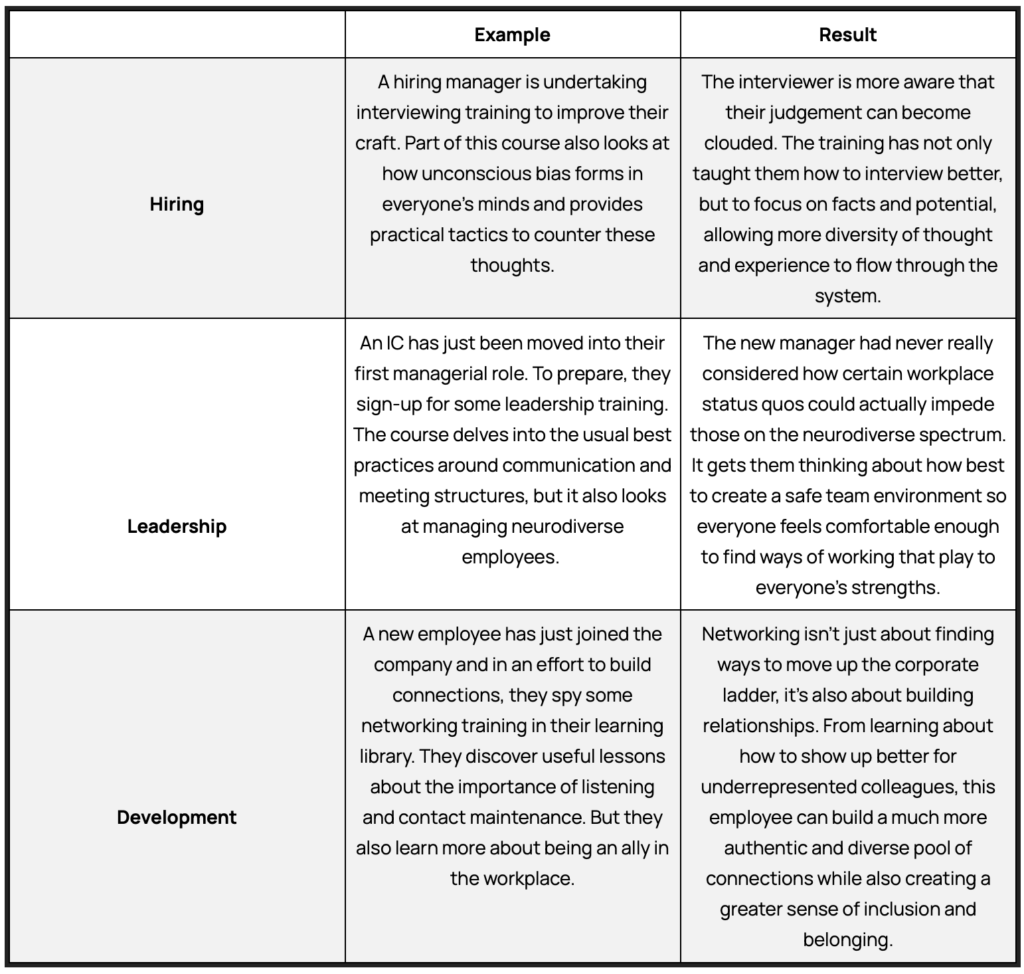Cultivating Inclusive Workplaces Through the Power of Learning
In a world brimming with diverse cultures, perspectives, and experiences, the importance of understanding in the workplace cannot be overstated. Former German President Roman Herzog once said that:
“Without mutual knowledge there can be no mutual understanding, and without understanding, there can be no trust and respect.”
This insight lays the foundation for our exploration of how cultivating a culture of learning in the workplace can also pave the way for a more inclusive environment.
DEI still remains a huge priority for organizations. Whether it’s trying to expand talent pools, embed a sense of belonging amongst employees, or create an atmosphere of psychological safety where everyone can thrive, companies are seeking out the most effective and sustainable approaches to bring diversity, equity, and inclusion to the forefront.
In this article, we delve into the role of continuous learning and development (L&D) in fostering an understanding of diverse perspectives, thereby building ingrained and sustainable trust and respect among employees. We will examine how a learning culture not only enhances individual knowledge and skill but also weaves a fabric of inclusivity and collaboration, making the workplace a microcosm of the diverse world we live in.

Knowledge is Power
A significant barrier to DEI success is this lack of awareness and unequal knowledge base. According to Salma El-Wardany, a SocialTalent author and renowned diversity advocate:
“One of the biggest failings of the DEI space is assuming everyone knows what you know.”
The path to a more inclusive workplace is undefined in terms of length and is wildly meandering. Everyone is at a different point in the journey, and one of the most powerful things an organization can do is provide their employees with the tools, resources, and training to get on a more level playing field. ‘We don’t know what we don’t know’ is a cliché for a reason – DEI is a HUGE topic. It gets to the very basis of what it means to be human, and if companies are only thinking short-term about their diversity, equity, and inclusion goals, there’s little chance they can authentically bake this culture in.
Learn more: What are the Benefits of DEI Training?
American journalist, Sydney J. Harris once said that “the purpose of education is to turn mirrors into windows.” Continuous learning, and creating a culture of this in the workplace, actively gives people the opportunity to step outside their comfort zone and experience difference. This simple act of broadening one’s horizon is therefore imperative when it comes to inclusion – remember, understanding begets respect, and the foundation of understanding is knowledge.
What Impact Can a Culture of Learning Have on Inclusion?
Whenever the topic of DEI comes up in the workplace, the usual response is that we can all do better. No matter where we sit on the scale of privilege, our understanding of different lived experiences can and should be expanded. It’s a lifelong lesson, really – but by fostering an environment that champions learning and development, you can create space for this growth.
DEI impacts every area of a business, and every level. But so can L&D. Learning is increasingly becoming an intrinsic feature of the modern workplace – so why not start here when it comes to inculcating a culture of inclusion?
Below are a few examples of how building a cohesive thread of learning can ultimately nurture inclusivity:

There are countless other examples of ways that learning can also bridge the gap of inclusion. Think about how company leaders can better understand the plight of underrepresented groups to grow more empathy, or how histories and information could be distributed during Pride Month to help bring more awareness to LGBTQ+ employees. Learning can happen in a variety of ways but the important thing is to continually encourage this pursuit.
The DEI / L&D Intersection
According to respondents in the SHRM Learning Report, one of the main goals for organisations leaning into L&D is to create a more diverse, equitable, and inclusive workplace (88%). The intersection between DEI and L&D is clear, but many companies struggle with the practical actions that can be taken to embed this approach. Here are SocialTalent’s golden rules:
- Make Sure Training is Accessible: In order to reap the benefits of a more inclusive culture from L&D, you have to ensure that however learning is primarily delivered in your workplace, it is accessible to all. Learning should not pose a barrier to anyone. So think different languages, captions, different forms of learning, and even the fonts and graphics.
- Lead By Example: As with many initiatives, it’s crucial that leaders pave the way and set an example that can inspire teams and departments. Leadership must be active, transparent, and forthright in how they approach their own development.
- Take Stock: It’s important to understand where your organization is thriving from an inclusivity standpoint, and where there is work to be done. Through surveys and feedback you can gauge this and work to see how learning can ameliorate the areas of shortcoming.
- Align Goals: Sometimes there can be a disconnect between learning and DEI goals within an organization. It’s important to engage all stakeholders to get on the same page and have an equal understanding of what’s being accomplished.
- Expand the Conversation: If inclusivity is the northstar, be sure not to silo learning too much. Reach out to your ERGs and other interested parties to get as many perspectives on how the culture of L&D can be improved and expanded.
Conclusion
Establishing a culture of learning within an organization is a fundamental step towards creating an inclusive environment that values diversity, equity, and inclusion.
A commitment to learning can act as the catalyst for profound organizational transformation. By equipping individuals with the knowledge to navigate and appreciate human diversity, we lay the groundwork for mutual respect, trust, and a collective sense of belonging. Through practical examples, from interviewing techniques that dismantle unconscious bias to leadership training that embraces neurodiversity, we can see firsthand how learning can sculpt an environment where every voice is heard, and every identity is celebrated.
The call to action is clear: to build an inclusive culture, we must also build a culture of learning. It is within this nurturing environment that diversity flourishes, innovation thrives, and organizations find their true strength in the wealth of their people’s varied experiences and perspectives.
